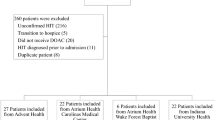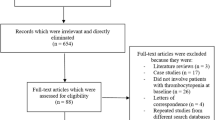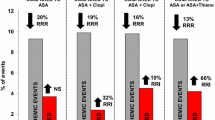Abstract
Accomplishing a successful percutaneous coronary intervention in a patient with a suspected or diagnosed heparin-induced thrombocytopenia (HIT) requires the selection of an appropriate alternative anticoagulant and a thorough assessment of bleeding and thrombotic risks. In this review, we suggest an evidence-based management algorithm that takes into account the clinical phase of HIT (acute, recent, and remote HIT) and the associated risk when patients present with acute coronary syndrome. The algorithm also integrates preventive measures directed at decreasing the bleeding risk associated with the antithrombotic and invasive therapies used for HIT and percutaneous coronary intervention.
Similar content being viewed by others
References and Recommended Reading
Warkentin TE, Kelton JG:A 14-year study of heparin-induced thrombocytopenia.Am J Med 1996,101: 502–507.
Warkentin TE:Heparin-induced thrombocytopenia: IgG-mediated platelet activation, platelet microparticle generation, and altered procoagulant/anticoagulant balance in the pathogenesis of thrombosis and venous limb gangrene complicating heparin-induced thrombocytopenia.Transfus Med Rev 1996,10: 249–258.
Warkentin TE:Heparin-induced thrombocytopenia: pathogenesis and management.Br J Haematol 2003,121: 535–555.
Of major importance Foo SY, Everett BM, Yeh RW, et al.:Prevalence of heparin-induced thrombocytopenia in patients undergoing cardiac catheterization.Am Heart J 2006,152: 290–297. This trial provides important insights into the prevalence of HIT among patients undergoing PCI. The seroconversion rate (7.6%) reported in this trial is significantly higher than what has previously been reported in other cardiac populations. This suggests that among all the patients receiving heparin in modern cardiology practice, patients in the catheterization laboratory are particularly at risk for developing HIT.
Warkentin TE, Kelton JG:Temporal aspects of heparin-induced thrombocytopenia.N Engl J Med 2001,344: 1286–1292.
Pouplard C, Amiral J, Borg JY, et al.:Decision analysis for use of platelet aggregation test, carbon 14-secrotonin release assay, and heparin-platelet factor 4 enzyme-linked immunosorbent assay for diagnosis of heparin-induced thrombocytopenia.Am J Clin Pathol 1999,111: 700–706.
Pötzsch B, Klovekorn WP, Madlener K:Use of heparin during cardiopulmonary bypass in patients with a history of heparin-induced thrombocytopenia.N Engl J Med 2000,343: 515.
Silber S, Albertsson P, Aviles FF, et al.:Guidelines for percutaneous coronary interventions. The Task Force for Percutaneous Coronary Interventions of the European Society of Cardiology.Eur Heart J 2005,26: 804–847.
Smith SC Jr, Feldman TE, Hirshfeld JW Jr, et al.:ACC/AHA/SCAI 2005 guideline update for percutaneous coronary intervention: a report of the American College of Cardiology/American Heart Association Task Force on Practice Guidelines (ACC/AHA/SCAI Writing Committee to Update 2001 Guidelines for Percutaneous Coronary Intervention).Circulation 2006,113: e166-e286.
Williams RT, Damaraju LV, Mascelli MA, et al.:Anti-platelet factor 4/heparin antibodies: an independent predictor of 30-day myocardial infarction after acute coronary ischemic syndromes.Circulation 2003,107: 2307–2312.
Wester JP, Leyte A, Oudemans-van Straaten HM, et al.:Low-dose fondaparinux in suspected heparin-induced thrombocytopenia in the critically ill.Neth J Med 2007,65: 101–108.
Efird LE, Kockler DR:Fondaparinux for thromboembolic treatment and prophylaxis of heparin-induced thrombocytopenia.Ann Pharmacother 2006,40: 1383–1387.
The OASIS Investigators:Effects of fondaparinux on mortality and reinfarction in patients with acute ST-segment elevation myocardial infarction: the OASIS-6 randomized trial.JAMA 2006,295: 1519–1530.
Magnani HN, Gallus A:Heparin-induced thrombocytopenia (HIT): a report of 1,478 clinical outcomes of patients treated with danaparoid (Orgaran) from 1982 to mid-2004.Thromb Haemost 2006,95: 967–981.
Weitz JI, Hudoba M, Massel D, et al.:Clot-bound thrombin is protected from inhibition by heparin-antithrombin III but is susceptible to inactivation by antithrombin III-independent inhibitors.J Clin Invest 1990,86: 385–391.
Direct Thrombin Inhibitor Trialists’ Collaborative Group:Direct thrombin inhibitors in acute coronary syndromes: principal results of a meta-analysis based on individual patients’ data.Lancet 2002,359: 294–302.
Sinnaeve PR, Simes J, Yusuf S, et al.:Direct thrombin inhibitors in acute coronary syndromes: effect in patients undergoing early percutaneous coronary intervention.Eur Heart J 2005,26: 2396–2403.
Stone GW, McLaurin BT, Cox DA, et al.:Bivalirudin for patients with acute coronary syndromes.N Engl J Med 2006,355: 2203–2216.
Roe MT, Granger CB, Puma JA, et al.:Comparison of benefits and complications of hirudin versus heparin for patients with acute coronary syndromes undergoing early percutaneous coronary intervention.The Am J Cardiol 2001,88: 1403–1406.
Of major importance Selleng K, Warkentin TE, Greinacher A:Heparin-induced thrombocytopenia in intensive care patients.Crit Care Med 2007,35: 1165–1176. A comprehensive review on the use of alternative anticoagulation in the management of HIT in intensive care patients. It proposes algorithms for dose adjustment of lepirudin, argatroban, and danaparoid.
Of major importance Tardy B, Lecompte T, Boelhen F, et al.:Predictive factors for thrombosis and major bleeding in an observational study in 181 patients with heparin-induced thrombocytopenia treated with lepirudin.Blood 2006,108: 1492–1496. This study is one of the very few that provides information on bleeding complications among patients with HIT. The results suggest that the labeled lepirudin dose may be associated with excessive bleeding risk in critically ill patients with HIT.
Pinto DS, Sperling RT, Tu TM, et al.:Combination platelet glycoprotein IIb/IIIa receptor and lepirudin administration during percutaneous coronary intervention in patients with heparin-induced thrombocytopenia.Catheter Cardiovasc Interv 2003,58: 65–68.
Manfredi JA, Wall RP, Sane DC, Braden GA:Lepirudin as a safe alternative for effective anticoagulation in patients with known heparin-induced thrombocytopenia undergoing percutaneous coronary intervention: case reports.Catheter Cardiovasc Interv 2001,52: 468–472.
Cochran K, DeMartini TJ, Lewis BE, et al.:Use of lepirudin during percutaneous vascular interventions in patients with heparin-induced thrombocytopenia.J Invasive Cardiol 2003,15: 617–621.
Lewis BE, Matthai WH Jr, Cohen M, et al.:Argatroban anticoagulation during percutaneous coronary intervention in patients with heparin-induced thrombocytopenia.Catheter Cardiovasc Interv 2002,57: 177–184.
Bates SM:Direct thrombin inhibitors for treatment of arterial thrombosis: potential differences between bivalirudin and hirudin.Am J Cardiol 1998,82(Suppl 1): 12P-18P.
Lincoff AM, Bittl JA, Harrington RA, et al.:Bivalirudin and provisional glycoprotein IIb/IIIa blockade compared with heparin and planned glycoprotein IIb/IIIa blockade during percutaneous coronary intervention: REPLACE-2 randomized trial.JAMA 2003,289: 853–863.
Mahaffey KW, Lewis BE, Wildermann NM, et al.:The anticoagulant therapy with bivalirudin to assist in the performance of percutaneous coronary intervention in patients with heparin-induced thrombocytopenia (ATBAT) study: main results.J Invasive Cardiol 2003,15: 611–616.
Seybert AL, Coons JC, Zerumsky K:Treatment of heparin-induced thrombocytopenia: is there a role for bivalirudin? Pharmacotherapy 2006,26: 229–241.
Warkentin TE, Greinacher A:Heparin-induced thrombocytopenia: recognition, treatment, and prevention: the seventh ACCP Conference on Antithrombotic and Thrombolytic Therapy.Chest 2004,126: 311S-337S.
Beiderlinden M, Treschan TA, Gorlinger K, Peters J:Argatroban anticoagulation in critically ill patients (May).Ann Pharmacother 2007,41: 749–754.
Waksman R, Wolfram RM, Torguson RL, et al.:Switching from enoxaparin to bivalirudin in patients with acute coronary syndromes without ST-segment elevation who undergo percutaneous coronary intervention: results from SWITCH—a multicenter clinical trial.J Invasive Cardiol 2006,18: 370–375.
White HD, Stone GW:Safety and efficacy of crossover from enoxaparin or unfractionated heparin to bivalirudin: results from ACUITY [abstract].Circulation 2006,114: 551.
Antman EM, McCabe CH, Braunwald E:Bivahrudin as a replacement for unfractionated heparin in unstable angina/non-ST-elevation myocardial infarction: observations from the TIMI 8 trial. Thrombolysis in Myocardial Infarction.Am Heart J 2002,143: 229–234.
Eikelboom JW, Mehta SR, Anand SS, et al.:Adverse impact of bleeding on prognosis in patients with acute coronary syndromes.Circulation 2006,114: 774–782.
Greinacher A, Eichler P, Lubenow N, et al.:Heparin-induced thrombocytopenia with thromboembolic complications: meta-analysis of 2 prospective trials to assess the value of parenteral treatment with lepirudin and its therapeutic aPTT range.Blood 2000,96: 846–851.
Lewis BE, Wallis DE, Berkowitz SD, et al.:Argatroban anticoagulant therapy in patients with heparin-induced thrombocytopenia.Circulation 2001,103: 1838–1843.
Arepally GM, Ortel TL:Clinical practice: heparin-induced thrombocytopenia.N Engl J Med 2006,355: 809–817.
McClure MW, Berkowitz SD, Sparapani R, et al.:Clinical significance of thrombocytopenia during a non-ST-elevation acute coronary syndrome: the platelet glycoprotein IIb/IIIa in unstable angina: receptor suppression using integrilin therapy (PURSUIT) trial experience.Circulation 1999,99: 2892–2900.
Nikolsky E, Sadeghi HM, Effron MB, et al.:Impact of in-hospital acquired thrombocytopenia in patients undergoing primary angioplasty for acute myocardial infarction.Am J Cardiol 2005,96: 474–481.
Jolicoeur EM, Ohman EM, Honeycutt E, et al.:Bleeding is common among patients treated with heparin experiencing thrombocytopenia and confers a high mortality risk: report from the CATCH registry [abstract].J Am Coll Cardiol 2007,49: 340.
Jaffe R, Hong T, Sharieff W, et al.:Comparison of radial versus femoral approach for percutaneous coronary interventions in octogenarians.Catheter Cardiovasc Interv 2006,69: 815–820.
Louvard Y, Benamer H, Garot P, et al.:Comparison of transradial and transfemoral approaches for coronary angiography and angioplasty in octogenarians (the OCTOPLUS study).Am J Cardiol 2004,94: 1177–1180.
Ziakas A, Klinke P, Mildenberger R, et al.:Comparison of the radial and femoral approaches in left main PCI: a retrospective study.J Invasive Cardiol 2004,16: 129–132.
Cantor WJ, Leblanc K, Garvey B, et al.:Combined use of Orgaran and Reopro during coronary angioplasty in patients unable to receive heparin.Catheter Cardiovasc Interv 1999,46: 352–355.
Koreny M, Riedmuller E, Nikfardjam M, et al.:Arterial puncture closing devices compared with standard manual compression after cardiac catheterization: systematic review and meta-analysis.JAMA 2004,291: 350–357.
Of importance Keeling D, Davidson S, Watson H:The management of heparin-induced thrombocytopenia.Br J Haematol 2006,133: 259–269. To our knowledge, the Haemostasis and Thrombosis Task Force of the British Committee for Standards in Hematology was the first society to give explicit recommendations on the length of antico-agulation for patients with isolated HIT. Their recommendation is based on the observation that most thrombotic complications occur within the first month after seroconversion.
Buresly K, Eisenberg MJ, Zhang X, Pilote L:Bleeding complications associated with combinations of aspirin, thienopyridine derivatives, and warfarin in elderly patients following acute myocardial infarction.Arch Intern Med 2005,165: 784–789.
Khurram Z, Chou E, Minutello R, et al.:Combination therapy with aspirin, clopidogrel and warfarin following coronary stenting is associated with a significant risk of bleeding.J Invasive Cardiol 2006,18: 162–164.
Berger PB, Bell MR, Hasdai D, et al.:Safety and efficacy of ticlopidine for only 2 weeks after successful intracoronary stent placement.Circulation 1999,99: 248–253.
Stone GW, Bertrand M, Colombo A, et al.:Acute Catheterization and Urgent Intervention Triage strategY (ACUITY) trial: study design and rationale.Am Heart J 2004,148: 764–775.
Kiser TH, Fish DN:Evaluation of bivalirudin treatment for heparin-induced thrombocytopenia in critically ill patients with hepatic and/or renal dysfunction.Pharmacotherapy 2006,26: 452–460.
Campbell KR, Mahaffey KW, Lewis BE, et al.:Bivalirudin in patients with heparin-induced thrombocytopenia undergoing percutaneous coronary intervention.J Invasive Cardiol 2000,12 (Suppl F): 14F-19F.
Lewis BE, Wallis DE, Leya F, et al.:Argatroban anticoagulation in patients with heparin-induced thrombocytopenia.Arch Intern Med 2003,163: 1849–1856.
Author information
Authors and Affiliations
Corresponding author
Rights and permissions
About this article
Cite this article
Marc Jolicoeur, E., Wang, T., Lopes, R.D. et al. Percutaneous coronary interventions in patients with heparin-induced thrombocytopenia. Curr Cardiol Rep 9, 396–405 (2007). https://doi.org/10.1007/BF02938367
Issue Date:
DOI: https://doi.org/10.1007/BF02938367




